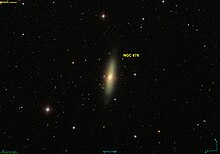NGC 676
| NGC 676 | |
|---|---|
 NGC 676 galaxy seen by Sloan Digital Sky Survey. Diffraction spikes are due to the star BD +04 0244, superposed on the nucleus.[1] | |
| Observation data (J2000 epoch) | |
| Constellation | Pisces |
| Right ascension | 01h 48m 57.310s[2] |
| Declination | +5° 54′ 27.10″[2] |
| Redshift | 0.004983±0.000083[3] |
| Distance | 18.7 Mpc (61 Mly) [2] |
| Apparent magnitude (V) | 10.5 +/- 0.4 [4] |
| Characteristics | |
| Type | S0/a: edge-on[2] |
| Apparent size (V) | 4.0′ × 1.2′[2] |
| Other designations | |
| UGC 01270; Ark 057;[5] CGCG 412-028; CGCG 0146.3+0540, PGC 6656[2] | |
NGC 676 is a lenticular[6] Seyfert 2 galaxy[4] about 18.7 Mly away in the constellation Pisces.[2] It can be seen near the star α Piscium.[6] Located close to the celestial equator, it is visible from both hemispheres.[6] BD +04 0244, a star with a visual magnitude of 10.44, is superposed 5.1 arc seconds south-southwest of the nucleus.[2] It is one of the 621 galaxies described in Marat Arakelian's catalog of high-surface-brightness galaxies.[5]

See also
[edit]References
[edit]- ^ Nemiroff, Robert; Bonnell, Jerry (15 April 2001). "Diffraction Spikes: When Stars Look Like Crosses". Astronomy Photo of the Day. Astrophysics Science Division at NASA. Retrieved 26 August 2020.
Unusual appendages around bright stars are commonplace, but never seem to be mentioned. What are they? First, a telescope brings starlight falling over a large area to a small area. To get at this small area, however, one must go inside a reflecting telescope, and one good way to do this is to use support rods, which are right in the view of the telescope. The wave nature of light causes it to deflect when passing near these rods. Light scatters away from the original destination point ending up elsewhere and appearing as "diffraction spikes". These annoying spikes steal precious light from the central image and hide light from fainter, more interesting stars.
- ^ a b c d e f g h "NASA/IPAC Extragalactic Database". Results for NGC 676. Retrieved 22 August 2020.
- ^ Paturel, G; Dubois, P; Petit, C; Woelfel, F (January 2002). "Comparison LEDA/SIMBAD". LEDA. Bibcode:2002LEDA.........0P. Retrieved 24 August 2020.
- ^ a b "NGC 676". SIMBAD. The Centre de Données Astronomiques de Strasbourg (CDS). Retrieved 23 August 2020.
- ^ a b Arakelian, Marat (January 1975). "The Galaxies of High Surface Brightness". Communications of the Byurakan Astrophysical Observatory. 47: 3–42. Bibcode:1975CoBAO..47....3A. Retrieved 25 August 2020.
- ^ a b c "NGC 676 - Lenticular Galaxy". TheSkyLive.com. Retrieved 23 August 2020.
External links
[edit] Media related to NGC 676 at Wikimedia Commons
Media related to NGC 676 at Wikimedia Commons- NGC 676 on WikiSky: DSS2, SDSS, GALEX, IRAS, Hydrogen α, X-Ray, Astrophoto, Sky Map, Articles and images
- Students for the Exploration and Development of Space - NGC 676
- Telescopius - NGC 676
- SkyMap.org - NGC 676
- NGC 676 on SIMBAD
Text is available under the CC BY-SA 4.0 license; additional terms may apply.
Images, videos and audio are available under their respective licenses.
